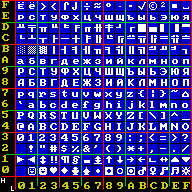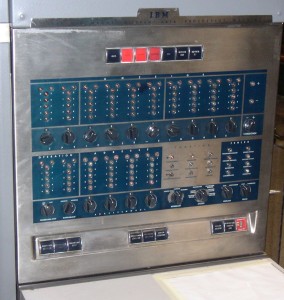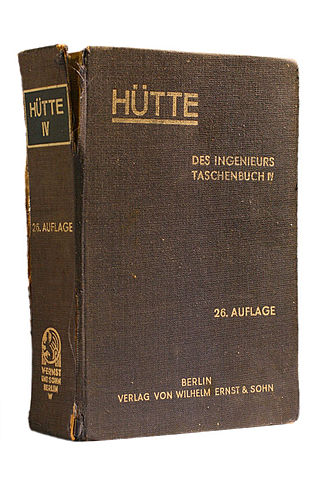
In computing and electronic systems, binary-coded decimal (BCD) is a class of binary encodings of decimal numbers where each digit is represented by a fixed number of bits, usually four or eight. Sometimes, special bit patterns are used for a sign or other indications.

In computing, a nibble (occasionally nybble, nyble, or nybl to match the spelling of byte) is a four-bit aggregation, or half an octet. It is also known as half-byte or tetrade. In a networking or telecommunication context, the nibble is often called a semi-octet, quadbit, or quartet. A nibble has sixteen (24) possible values. A nibble can be represented by a single hexadecimal digit (0–F) and called a hex digit.
The reflected binary code (RBC), also known as reflected binary (RB) or Gray code after Frank Gray, is an ordering of the binary numeral system such that two successive values differ in only one bit.
A binary code represents text, computer processor instructions, or any other data using a two-symbol system. The two-symbol system used is often "0" and "1" from the binary number system. The binary code assigns a pattern of binary digits, also known as bits, to each character, instruction, etc. For example, a binary string of eight bits can represent any of 256 possible values and can, therefore, represent a wide variety of different items.
Quaternary is a numeral system with four as its base. It uses the digits 0, 1, 2, and 3 to represent any real number. Conversion from binary is straightforward.
Bi-quinary coded decimal is a numeral encoding scheme used in many abacuses and in some early computers, including the Colossus. The term bi-quinary indicates that the code comprises both a two-state (bi) and a five-state (quinary) component. The encoding resembles that used by many abacuses, with four beads indicating the five values either from 0 through 4 or from 5 through 9 and another bead indicating which of those ranges.
Excess-3, 3-excess or 10-excess-3 binary code, shifted binary or Stibitz code is a self-complementary binary-coded decimal (BCD) code and numeral system. It is a biased representation. Excess-3 code was used on some older computers as well as in cash registers and hand-held portable electronic calculators of the 1970s, among other uses.
Chen–Ho encoding is a memory-efficient alternate system of binary encoding for decimal digits.
A ring counter is a type of counter composed of flip-flops connected into a shift register, with the output of the last flip-flop fed to the input of the first, making a "circular" or "ring" structure.
Densely packed decimal (DPD) is an efficient method for binary encoding decimal digits.

A reed relay is a type of relay that uses an electromagnet to control one or more reed switches. The contacts are of magnetic material and the electromagnet acts directly on them without requiring an armature to move them. Sealed in a long, narrow glass tube, the contacts are protected from corrosion. The glass envelope may contain multiple reed switches or multiple reed switches can be inserted into a single bobbin and actuate simultaneously. Reed switches have been manufactured since the 1930s.
In digital logic, a don't-care term for a function is an input-sequence for which the function output does not matter. An input that is known never to occur is a can't-happen term. Both these types of conditions are treated the same way in logic design and may be referred to collectively as don't-care conditions for brevity. The designer of a logic circuit to implement the function need not care about such inputs, but can choose the circuit's output arbitrarily, usually such that the simplest circuit results (minimization).

Gillham code is a zero-padded 12-bit binary code using a parallel nine- to eleven-wire interface, the Gillham interface, that is used to transmit uncorrected barometric altitude between an encoding altimeter or analog air data computer and a digital transponder. It is a modified form of a Gray code and is sometimes referred to simply as a "Gray code" in avionics literature.

A decimal computer is a computer that can represent numbers and addresses in decimal and that provides instructions to operate on those numbers and addresses directly in decimal, without conversion to a pure binary representation. Some also had a variable wordlength, which enabled operations on numbers with a large number of digits.
In digital computing and telecommunications, a unit of information is the capacity of some standard data storage system or communication channel, used to measure the capacities of other systems and channels. In information theory, units of information are also used to measure information contained in messages and the entropy of random variables.
BCD, also called alphanumeric BCD, alphameric BCD, BCD Interchange Code, or BCDIC, is a family of representations of numerals, uppercase Latin letters, and some special and control characters as six-bit character codes.
The hartley, also called a ban, or a dit, is a logarithmic unit that measures information or entropy, based on base 10 logarithms and powers of 10. One hartley is the information content of an event if the probability of that event occurring is 1⁄10. It is therefore equal to the information contained in one decimal digit, assuming a priori equiprobability of each possible value. It is named after Ralph Hartley.

Bronshtein and Semendyayev is the informal name of a comprehensive handbook of fundamental working knowledge of mathematics and table of formulas originally compiled by the Russian mathematician Ilya Nikolaevich Bronshtein and engineer Konstantin Adolfovic Semendyayev.

Wolfgang Händler was a German mathematician, pioneering computer scientist and professor at Leibniz University Hannover and University of Erlangen–Nuremberg known for his work on automata theory, parallel computing, artificial intelligence, man-machine interfaces and computer graphics.

The Hütte - Das Ingenieurwissen is a reference work for engineers of various disciplines. It was compiled for the first time in 1857 by the Akademischer Verein Hütte of the Königliches Gewerbe-Institut in Berlin, from which the association of German engineers Verein Deutscher Ingenieure (VDI) emerged. The authors were members of the association. The technical illustrations were created in woodcut technique by Otto Ebel. It is published in constantly revised editions to this day and is therefore the oldest German reference work still available today.









